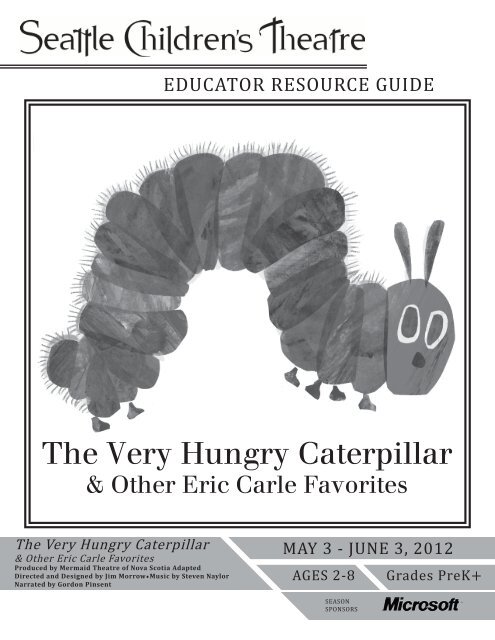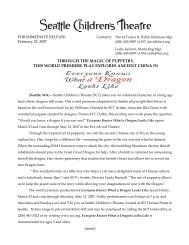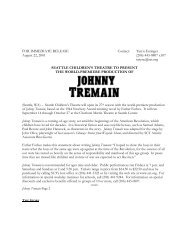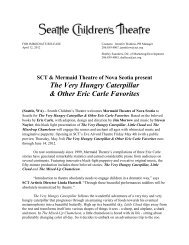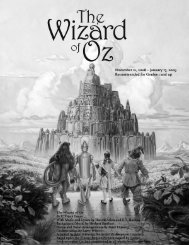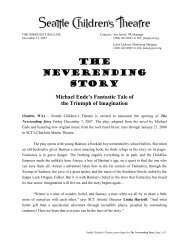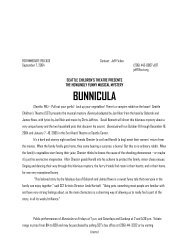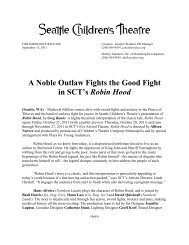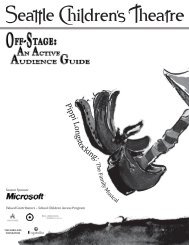The Very Hungry Caterpillar ERG - Seattle Children's Theatre
The Very Hungry Caterpillar ERG - Seattle Children's Theatre
The Very Hungry Caterpillar ERG - Seattle Children's Theatre
You also want an ePaper? Increase the reach of your titles
YUMPU automatically turns print PDFs into web optimized ePapers that Google loves.
EDUCATOR RESOURCE GUIDE<br />
<strong>The</strong> <strong>Very</strong> <strong>Hungry</strong> <strong>Caterpillar</strong><br />
& Other Eric Carle Favorites<br />
<strong>The</strong> <strong>Very</strong> <strong>Hungry</strong> <strong>Caterpillar</strong><br />
& Other Eric Carle Favorites<br />
Produced by Mermaid <strong>The</strong>atre of Nova Scotia Adapted<br />
Directed and Designed by Jim Morrow Music by Steven Naylor<br />
Narrated by Gordon Pinsent<br />
MAY 3 - JUNE 3, 2012<br />
AGES 2-8 Grades PreK+<br />
SEASON<br />
SPONSORS
presents<br />
<strong>The</strong> <strong>Very</strong> <strong>Hungry</strong> <strong>Caterpillar</strong><br />
& Other Eric Carle Favorites<br />
Table of Contents<br />
Synopsis................................................................................................................. 3<br />
Curriculum Connections and EALRs......................................................... 4<br />
Eric Carle - <strong>The</strong> <strong>Very</strong> Wonderful Artist..................................................... 5<br />
Words, Actions & Ideas................................................................................... 6-7<br />
Puppetry in <strong>The</strong> <strong>Very</strong> <strong>Hungry</strong> <strong>Caterpillar</strong>................................................ 8<br />
Activity Pages...................................................................................................... 9-11<br />
Booklist.................................................................................................................. 12<br />
Evaluation Form................................................................................................ 13<br />
2
SYNOPSIS<br />
Mermaid <strong>The</strong>atre draws upon puppetry and black light to capture the charm of three favorite<br />
Eric Carle stories:<br />
Little Cloud<br />
While all the other clouds drift slowly across the<br />
sky, Little Cloud trails behind. He touches the tops<br />
of houses and trees. He changes shape to become a<br />
sheep, an airplane, a shark, and even a clown wearing<br />
a funny hat. When the other clouds drift back<br />
and call to Little Cloud, he happily joins them to<br />
become one big cloud. And then they rain!<br />
<strong>The</strong> Mixed-Up Chameleon<br />
A small green chameleon lives his<br />
life just like all chameleons do. He<br />
changes colors depending on where<br />
he is and how he feels. When he’s<br />
hungry, he catches flies with his long<br />
sticky tongue. It’s not a very exciting<br />
life, but it’s all he knows - until he<br />
sees a zoo and all the wonderful<br />
animals there. What would it be like<br />
to be as big as a polar bear, as handsome as a flamingo, to swim like a fish? He transforms himself<br />
bit by bit until he is completely mixed-up and looks like all the animals at once. But is he<br />
happy? No. It turns out that being a small green chameleon suits him best after all.<br />
<strong>The</strong> <strong>Very</strong> <strong>Hungry</strong> <strong>Caterpillar</strong><br />
An egg sits on a leaf in the light of the Moon. When the Sun comes up,<br />
a tiny hungry caterpillar comes out of the egg, looking for food. On<br />
Monday he eats one apple. Tuesday, two pears. Wednesday, Thursday,<br />
Friday – three plums, four strawberries, five oranges. On Saturday he<br />
unwisely eats everything from chocolate cake to salami. Eating one<br />
green leaf on Sunday makes his stomach feel much better. Now he’s<br />
not so tiny or hungry anymore. He builds a cocoon and lives inside<br />
it for more than two weeks. When he makes his way out he’s not a<br />
caterpillar at all. He is a beautiful butterfly.<br />
3
CURRICULUM CONNECTIONS & EALRS<br />
<strong>The</strong> <strong>Very</strong> <strong>Hungry</strong> <strong>Caterpillar</strong> and Other Eric Carle Favorites touches on many themes and ideas.<br />
Here are a few we believe would make good Curriculum Connections: Growth/Development, Days<br />
of the Week, Metamorphosis, Counting, Puppetry, Colors, Clouds, Adaptation, Creative Play.<br />
We believe that seeing the show and using our Educator Resource Guide can help you meet the<br />
following EALRs:<br />
State Standards:<br />
<strong>The</strong>atre<br />
Reading<br />
Science<br />
Communication<br />
1. <strong>The</strong> student understands and applies arts knowledge and skills.<br />
1.1 Understand arts concepts and vocabulary, specifically, identifies and<br />
describes characters, setting, actions, conflict, sounds<br />
1.2 Develops theatre skills and techniques.<br />
1.4 Understands and applies audience conventions in a variety of settings<br />
and performances of theatre.<br />
3. <strong>The</strong>atre: <strong>The</strong> student communicates through the arts (dance, music,<br />
theatre, and visual arts).<br />
3.1 Uses theatre to express feelings and present ideas.<br />
1. <strong>The</strong> student understands and uses different skills and strategies to read.<br />
1.1 Use word recognition skills and strategies to read and comprehend text.<br />
1.2 Use vocabulary (word meaning) strategies to comprehend text.<br />
1.3 Build vocabulary through wide reading.<br />
1.4 Apply word recognition skills and strategies to read fluently.<br />
2. <strong>The</strong> student understands the meaning of what is read.<br />
2.1 Demonstrate evidence of reading comprehension.<br />
2.3 Expand comprehension by analyzing, interpreting, and synthesizing<br />
information and ideas in literary and informational text.<br />
2.4 Think critically and analyze author’s use of language, style, purpose, and<br />
perspective in literary and informational text.<br />
3. <strong>The</strong> student reads different materials for a variety of purposes.<br />
3.1 Read to learn new information.<br />
3.2 Read to perform a task.<br />
3.4 Read for literary experience in a variety of genres.<br />
EALR 2: Inquiry. Big Idea: Inquiry (INQ). Core Content: Making Observations<br />
Students learn that scientific investigations involve trying to answer questions by<br />
making observations or trying things out, rather than just asking an adult. Children<br />
are naturally curious about nearly everything—butterflies and clouds, and<br />
why the Moon seems to follow them at night. <strong>The</strong> essence of this standard is to<br />
channel students’ natural curiosity about the world, so that they become better<br />
questioners, observers, and thinkers, laying the groundwork for increasing<br />
understanding and abilities in science inquiry in the years to come.<br />
1. <strong>The</strong> student uses listening and observation skills and strategies to gain<br />
understanding.<br />
1.1 Uses listening and observation skills and strategies to focus attention and<br />
interpret information.<br />
1.2 Understands, analyzes, synthesizes, or evaluates information from a variety<br />
of sources.<br />
4
ERIC CARLE - THE VERY WONDERFUL ARTIST<br />
Eric Carle is acclaimed and beloved as the creator of<br />
brilliantly illustrated and innovatively designed picture books<br />
for very young children. His best-known work, <strong>The</strong> <strong>Very</strong><br />
<strong>Hungry</strong> <strong>Caterpillar</strong>, has eaten its way into the hearts of<br />
literally millions of children all over the world and has been<br />
translated into more than 50 languages and sold over 33<br />
million copies.<br />
Born in Syracuse, New York, in 1929, Eric Carle moved with<br />
his parents to Germany when he was six years old; he was<br />
educated there, and graduated from the prestigious art<br />
school, the Akademie der bildenden Künste, in Stuttgart. But<br />
his dream was always to return to America, the land of his happiest childhood memories. So, in<br />
1952, with a fine portfolio in hand and forty dollars in his pocket, he arrived in New York. Soon<br />
he found a job as a graphic designer in the promotion department of <strong>The</strong> New York Times. Later,<br />
he was the art director of an advertising agency for many years.<br />
One day, respected educator and author, Bill Martin Jr., called to ask Carle to illustrate a story<br />
he had written. Brown Bear, Brown Bear, What Do You See? was the result of their collaboration.<br />
This was the beginning of Eric Carle’s true career. Soon Carle was writing his own stories, too.<br />
His first wholly original book was 1,2,3 to the Zoo, followed soon afterward by the celebrated<br />
classic, <strong>The</strong> <strong>Very</strong> <strong>Hungry</strong> <strong>Caterpillar</strong>.<br />
Eric Carle’s art is distinctive and instantly recognizable. His artwork is created in collage<br />
technique, using hand-painted papers, which he cuts and layers to form bright and cheerful<br />
images. Many of his books have an added dimension - die-cut pages, twinkling lights as in<br />
<strong>The</strong> <strong>Very</strong> Lonely Firefly, even the lifelike sound of a cricket’s song as in <strong>The</strong> <strong>Very</strong> Quiet<br />
Cricket - giving them a playful quality: a toy that can be read, a book that can be touched.<br />
<strong>The</strong> themes of his stories are usually drawn from his extensive knowledge and love of<br />
nature - an interest shared by most small children. Besides being beautiful and entertaining, his<br />
books always offer the child the opportunity to learn something about the world around them.<br />
Carle says: “With many of my books I attempt to bridge the gap between the home and school.<br />
To me home represents, or should represent warmth, security, toys, holding hands, being held.<br />
School is a strange and new place for a child. Will it be a happy place? <strong>The</strong>re are new people, a<br />
teacher, classmates - will they be friendly? <strong>The</strong> unknown often brings fear with it. In my books I<br />
try to counteract this fear, to replace it with a positive message. I believe that children are<br />
naturally creative and eager to learn. I want to show them that learning is really both fascinating<br />
and fun.”<br />
Excerpted from <strong>The</strong> Official Eric Carle Web Site:<br />
http://www.eric-carle.com/home.html<br />
5
WORDS, ACTIONS & IDEAS<br />
HOW THE PLAY IS PERFORMED<br />
black light: invisible ultraviolet light. A black-light bulb seems to give off only a faint purple light, but it<br />
can make things that are white or fluorescent glow in the dark.<br />
puppetry: the art of creating special objects (puppets) and then bringing those objects to life on stage<br />
narrator: a person who tells a story by writing or speaking<br />
LITTLE CLOUD<br />
cloud: a visible body of very fine water droplets or ice particles<br />
suspended high in the air<br />
drift: to be carried along by currents of air or water<br />
trail: to follow behind<br />
ocean: a vast body of salt water that is home to sharks, whales, fish,<br />
and other underwater creatures<br />
dash: to run quickly<br />
meadow: an open area of land covered by nature in grasses and<br />
flowering plants<br />
huddle: to pack together in a group<br />
water cycle: the natural sequence in which water warms up to become<br />
wtater vapor, condenses into clouds, falls back to earth as rain,<br />
sleet, or snow, and then warms to<br />
become water vapor again, and so on<br />
Actions in the story:<br />
drifted slowly moved drifted back<br />
trailed behind changed huddled close together<br />
pushed upward and away flying through drifted toward<br />
pushed downward<br />
stayed in one place<br />
touched<br />
dash across<br />
Continued on the next page...<br />
6
THE MIXED-UP CHAMELEON<br />
chameleon: a lizard that can change color. Most can change from brown<br />
to green and then back from green to brown, but some chameleons can<br />
change to almost any color.<br />
camouflage: special coloring and patterns that allow an animal or person<br />
to blend into their surroundings<br />
Colors the chameleon becomes:<br />
green brown - brownish red - reddish yellow - yellowish grey<br />
What the chameleon wishes he could be:<br />
big and white like a polar bear strong like an elephant<br />
handsome like a flamingo<br />
funny like a seal<br />
smart like a fox<br />
What the chameleon wishes he could do:<br />
swim like a fish<br />
see things far away like a giraffe<br />
run like a deer<br />
hide in a shell like a turtle<br />
A VERY HUNGRY CATERPILLAR<br />
egg: the very first stage of life for many young animals, during<br />
which the animal is protected by a shell. Birds, fish, reptiles,<br />
amphibians, and insects hatch from eggs.<br />
caterpillar: the worm-like phase that makes up a butterfly’s<br />
feeding and growth stage<br />
cocoon: a case or covering of silky strands spun by an insect that<br />
serves as a protective covering<br />
butterfly: a type of insect that usually has a slender body, knobbed<br />
antennae, and four broad wings that are often colorful<br />
metamorphosis: a dramatic change in form and physical appearance<br />
What the caterpillar eats:<br />
apple ice cream cone sausage<br />
pears pickle cupcake<br />
plums slice of Swiss cheese slice of watermelon<br />
strawberries slice of salami green leaf<br />
oranges<br />
lollipop<br />
piece of chocolate cake piece of cherry pie<br />
7
PUPPETRY IN THE VERY HUNGRY CATERPILLAR<br />
<strong>The</strong> <strong>Very</strong> <strong>Hungry</strong> <strong>Caterpillar</strong> & Other Eric Carle Favorites is told entirely through the use of<br />
black-light puppetry and narration. In all three stories presented in this production, a main<br />
character goes through a series of physical transformations. Puppetry allows the play to<br />
illustrate those changes in a fascinating way.<br />
Black-light puppetry uses a stage lit with ultraviolet, or black, lights. <strong>The</strong> puppeteers and some of<br />
the architecture of the stage are covered in black velvet, which cannot be seen under the lights.<br />
This allows the puppeteers to be completely hidden, while the puppets can be any size and have<br />
a large range of motion. <strong>The</strong> puppets themselves are fluorescent colored, so they are fully visible<br />
and able to move or float in what sometimes seems to be midair - or even disappear.<br />
<strong>The</strong> way in which the puppets are manipulated is born out of<br />
the ancient tradition of Bunraku puppetry, originally developed<br />
in Japan. This style of puppetry has multiple puppeteers<br />
operating one puppet by moving different rods attached to its<br />
feet, hands and head. Bunraku puppeteers dress in black<br />
clothing to attempt to blend into the background as much as<br />
possible. Bunraku plays feature traditional Japanese music and<br />
tell popular stories that the audience often knows beforehand.<br />
This is similar to <strong>The</strong> <strong>Very</strong> <strong>Hungry</strong> <strong>Caterpillar</strong>, which is told<br />
with music and narration from the books themselves.<br />
Bunraku puppeteers<br />
This style of presentation allows the puppeteers to mirror Eric Carle’s<br />
collage illustrations while making the stories come alive with movement<br />
and texture. <strong>The</strong> audience sees the stories performed in a way<br />
that stays true to the spirit of Eric Carle’s books.<br />
Operating <strong>The</strong> <strong>Very</strong><br />
<strong>Hungry</strong> <strong>Caterpillar</strong> puppet<br />
ACTIVITY:<br />
Puppetry is a form of theater that can easily be recreated at home or in the classroom to<br />
explore stories, feelings, problems and transformations.<br />
Have the students write a short story and create a paper bag puppet of one of the characters<br />
in their story. Attach material like pipe cleaners, string, paper fasteners and rubber bands that<br />
can flow, jiggle, and bounce so the students can explore what happens when the puppet moves<br />
in different ways.<br />
8
BOOKLIST<br />
For Children & Young Adults:<br />
<strong>The</strong> Grouchy Ladybug<br />
Eric Carle<br />
<strong>The</strong> <strong>Very</strong> Busy Spider<br />
Eric Carle<br />
Brown Bear, Brown Bear, What Do You See?<br />
Bill Martin Jr.<br />
Caps for Sale<br />
Esphyr Slobodkina<br />
A Color of His Own<br />
Leo Lionni<br />
26 Letters and 99 Cents Planting a Rainbow<br />
Tana Hoban<br />
Lois Ehlert<br />
In the Small, Small Pond<br />
Denise Fleming<br />
Black? White! Day? Night! - A Book of Opposites<br />
Laura Vaccaro Seeger<br />
Freight Train<br />
Donald Crews<br />
This masterpiece by acclaimed designer and picture book author/illustrator Donald Crews<br />
has it all: colors, trains and an action-packed story!<br />
For Adults Working with Children & Young Adults:<br />
Mr. Gumpy’s Outing<br />
John Burningham<br />
I Went Walking<br />
Sue Williams<br />
Child of Wonder: Nurturing Creative & Naturally Curious Children<br />
Ginger Carlson<br />
Unplugged Play: No Batteries. No Plugs. Pure Fun.<br />
Bobbi Conner<br />
Chock full of activities (over 700) for all ages of children who are about the business of<br />
childhood: play!<br />
Booklist prepared by Steve DelVecchio,<br />
King County Library System<br />
12
HOW DID WE DO?<br />
We’d love to know what was helpful to you as you read and used this guide. Please fill out and<br />
return this short survey to us. We appreciate your feedback.<br />
1. For which play/plays did you use the Educator Resource Guide?<br />
Harold and the Purple Crayon<br />
A Year with Frog and Toad<br />
HELP<br />
Robin Hood<br />
A Single Shard<br />
<strong>The</strong> <strong>Very</strong> <strong>Hungry</strong> <strong>Caterpillar</strong><br />
2. Was it easy for you to find and download the Educator Resource Guide?<br />
<strong>Very</strong> Somewhat Not very Not at all<br />
3. On a scale of 1 – 5 (5 being the highest), how useful was the Educator Resource Guide?<br />
1 2 3 4 5<br />
4. What did you use from the Educator Resource Guide?<br />
5. Is there something you would like to see included in the Educator Resource Guide that<br />
wasn’t here?<br />
6. Which of the following best describes you? I teach:<br />
Preschool Middle school Homeschool<br />
Elementary School<br />
High school<br />
Other Comments:<br />
THANK YOU!<br />
MAIL: or FAX: or EMAIL:<br />
<strong>Seattle</strong> Children’s <strong>The</strong>atre 206.443.0442 schoolshows@sct.org<br />
Attention: School Shows<br />
201 Thomas Street<br />
<strong>Seattle</strong>, WA 98109<br />
13


